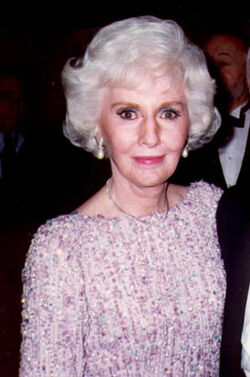Barbara Stanwyck was born on July 16, 1907 in Brooklyn, New York City, to Byron Stevens (the son of English immigrants) and Catherine McGee (whose parents were Irish). Her mother died when she was four, not long before her father abandoned the family. She was raised by an elder sister but began working at age 13, and was a Broadway chorine in 1922 at the age of 15.
Her first husband was established actor Frank Fay, and they were married from 1928 to 1936. On December 5, 1932 they adopted a son, Dion, who was one month old, from whom Stanwyck was later estranged. Fay's successful career on Broadway did not translate to the big screen, whereas Stanwyck achieved Hollywood stardom fairly rapidly. Also, Fay reportedly did not shy away from physical confrontations with his young wife, especially when he was inebriated. Some film historians claim that the Fay-Stanwyck marriage was the basis for A Star is Born. Stanwyck eventually became estranged from her son Dion for reasons that are still not known.
Some books have said that the younger actor Robert Taylor was less in love with Stanwyck than she was with him, but since they were already living together, their marriage was arranged with the help of the studio in view of the times, which was common in Hollywood's golden age. Other books have claimed that theirs was a tandem marriage, with both at least bisexual, if not homosexual.
Taylor was rumored to have had several affairs during the marriage, including one with Ava Gardner. Stanwyck was rumored to have attempted suicide when she learned of Taylor's fling with Lana Turner. She ultimately filed for divorce in 1950 when a starlet made her romance with Taylor public. After her divorce from Taylor, Stanwyck had several discreet romances including one which was revealed many years later by actor Robert Wagner, 23 years her junior.
She never remarried, collecting alimony of 15 percent from Taylor's salary until the day he died. According to one book, she tried to collect back alimony even after Taylor's death from his second wife, Ursula, even while Ursula was struggling with financial problems. However, Stanwyck's house once burned down and she was devastated that many of Taylor's old letters and photos were lost.
Stanwyck starred in almost a hundred films during her career and received four nominations for the Academy Award for Best Actress: Stella Dallas (1937), Ball of Fire (1941), Double Indemnity (1944), and Sorry, Wrong Number (1948). In her best films, such as The Lady Eve (1941), she often mixed a worldly toughness with heartbreaking vulnerability, particularly in her early Pre-Code films. She received an Academy Honorary Award "for superlative creativity and unique contribution to the art of screen acting" in 1982.
In her later years, she also starred in television, notably in the 1960's western series, "The Big Valley". Her last starring role was in 1985, on the TV series "The Colbys" alongside Charlton Heston, Stephanie Beacham and Katharine Ross.
When Stanwyck's film career declined at age 50 in 1957, she moved to television. Her 1961 -1962 series "The Barbara Stanwyck Show" was not a ratings success but earned the star her first Emmy Award. The 1964-1968 series "The Big Valley" made her one of the most popular actresses on television, winning her another Emmy. Twenty years later, she earned her third Emmy for "The Thorn Birds" (1983).
Although beloved by her directors and most of her co-workers for her lack of vanity and unprententiousness on film sets, Stanwyck was not without flaws. She was considerably less friendly with her younger female co-stars than the male ones, and was notorious for holding grudges against those whom she believed crossed her (like Bette Davis, with whom she appeared in a movie in 1932). Overall though, Stanwyck had a reputation as one of the least "difficult" silver screen goddesses.
Her retirement years were somewhat active, with charity work done completely out of the limelight, although she became somewhat reclusive following a robbery in her home while she was present, during which she was pushed into a closet, but fortunately suffered no serious physical injuries.
She died at age 82 of congestive heart disease at her home --the same home-- in Santa Monica, California in 1990.

